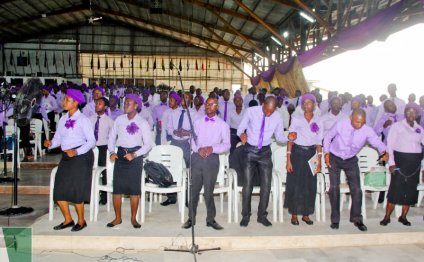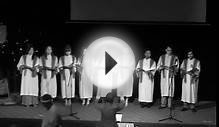
Choir uniforms for Church
We've received numerous requests for information on the history of choir robes.
A complete account of the origin and background history of choir gowns is beyond our research ability. However, this article offers a brief chronicle of the record of events from the past concerning the costumes and dress used in mostly religious and school institutions for choirs. Based on known documentation from that era, we attempt to report a chronology and timeline of those outfits known as choir robes.
Before delving into the far past, it's useful to keep in mind where we are now with choir robes. The modern religious and choral robe currently employs different robes, gowns, and vestments for different individuals and groups within the school, church, temple, or other religious or secular institution.
The Choir: In addition to the choir gowns for choir members, there is a directors robe and organists robe for specific members of the choir. Sometimes a bell choir will have their own type of choral gowns. For a children’s choral group you often find acolyte robes. Churches with multiple choirs will often have different choral vestments or choral uniforms for each choir.
The Sanctuary: Outside the choir for services, the types of church robes often include a robe for the lead speaker. Depending on the institution, this may be a minister robe, pulpit gown, church vestments, rabbinical gown, or doctoral robe. Finally, various specific religions and groups use clerical vestments for members of the clergy.
Specific Events: Certain specific events also require special church robes, such as baptismal robes for a baptism.
Schools and Choral Organizations: A variety of different styles are used for schools, amateur singing groups, and professional chorus or choral organizations (often along with a symphony or other musical accompaniment).
Origin of the Choir Robe - Timeline
Ancient Egypt
|
The earliest visual depiction of a group of singers performing can be found in ancient tombs in Egypt around 2700 BC. However, there was no indication of a robe, vestment, or other formal or organized clothing for such early choirs. The image to the right depicts what is believed to be a blind choir of ancient egypt. Ancient Greece and Rome The earliest evidence of a potentially-formal choir robe is found in ancient Greece. The Greek Chorus seems to have been relatively common in that era, and can be seen depicted on a portion of pottery dating from around 425 BC. That Greek pottery displays members of a choir both singing and playing musical instruments. The members of that ancient choir are seen wearing lengthy loose gowns that reach up and across their left shoulders. Those pictured in the pottery displayed to the left obviously have a slightly more elaborate design than the earliest depiction. The use of gowns likely developed from the ancient tunic. Indeed, clerical vestments such as an alb are directly related to the ancient tunic, with the word origin being a latin phrase meaning a tunic of white. Modern albs remain a plain, lightweight, ankle-length tunic with long sleeves, with a rope cincture about the waist. Ancient tunics were sleeveless, and were seen as a distinction from barbarians wore sleeved clothing (probably because those tribes lived in the colder regions). The tunic eventually did include a sleeve around the 3rd century, after military leaders returned from a campaign wearing them. This combination of tunic and choir evolved with time. Early Judaism The Jewish Torah (bible) provides some possible indications that choirs held a role for the early Hebrews. For example, Nehemiah Chapter 12, section 31 has the leaders of Judah assigning two choirs to offer thanks in some translations of that section. Jewish law dictates vestments or robes for the high priest and for certain other roles at this time as well. However, I have yet to find evidence that these choirs wore robes. Pictured to the right is a high priest of this era, in complete regalia. Early Christianity The first four centuries of Christianity did not involve a special robe, tunic, vestment or other garb for members of the clergy nor presumably for choirs used in a religious setting or otherwise. Tunics remained the primary article of clothing, typically knee-length to ankle-length, usually with a cincture. Often, an additional article of clothing known as a himation was worn. This was rectangular, and wrapped around ones body over the tunic. Himations came in various colors, qualities, and designs dependant on occupation, gender, and status. There is no evidence that the himation became a clerical vestment. Over time clergy vestments became richer and made of costlier materials, and beauty played a larger role in church garments. It is unknown if choirs of this time followed suit, though it seems likely. Medieval Era Until this time, music notations for choirs typically used only small notes sketched above words indicating the fall or rise of voice, but not duration or note pitch. Choir music evolved in this era to include the Gregorian chant, named after Pope Gregory I. He also mandated music standardization, including rules for composers and musicians for performing and writing music. Boys choirs also began to rise in prominence at this time. Because many of the better schools were associated with the Church, they also trained boys for choirs. Examples include the “Ratisbonne Choir”, started in Germany near the end of the tenth century, and “Kings College Choir” in England. Eventually, all major churches of the era included choristers. Choir fashions followed the fashion trends of clergy. With the rise of the surplice (white, sleeved, blouse-like shirt with lace trim worn over a cassock) worn over a cassock (plain black, long-sleeved, ankle-length tunic) as the official clergy garment, choirs also adopted this style. Uniformity and a formalization of a “choir look” came about. Renaissance Secular choirs started to gain influence once wealthy patrons started sponsoring musicians in the Renaissance period. The oldest written evidence of polyphonic choral singing dates from the late 1300s to around 1420 with the Old Hall Manuscript (pictured to the left). This document uses divisi (two or more voices per part). YOU MIGHT ALSO LIKE Choir Performance #1 ...
 "I Bless Your Name" -- Lancaster Baptist Church Choir and ...
Share this PostRelated postsChoir Uniforms for YouthJANUARY 17, 2026
The appearance of the choir is a vital component of a polished performance. It is the parents responsibility that their… Read MoreChoir songs for ChurchJANUARY 17, 2026
Looking around the church last Sunday I noticed that the majority weren’t singing. And most of those who were singing barely… Read More |











